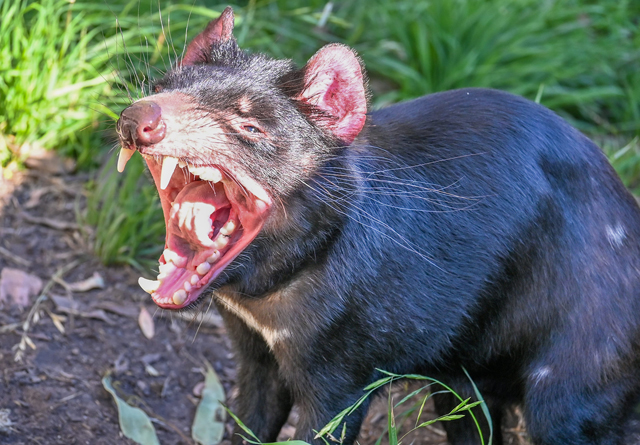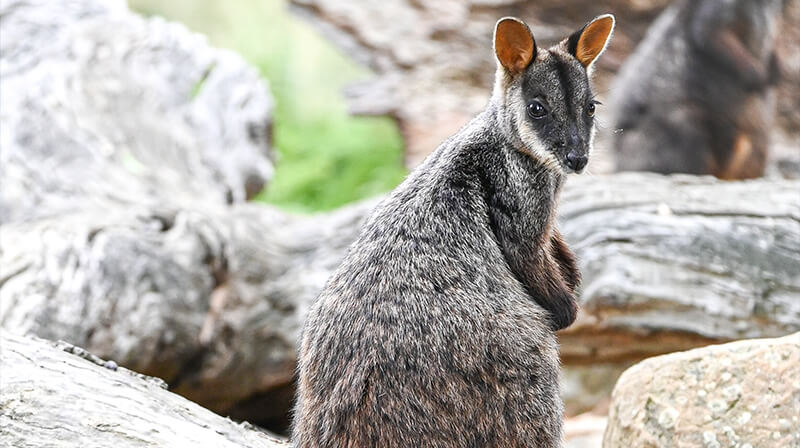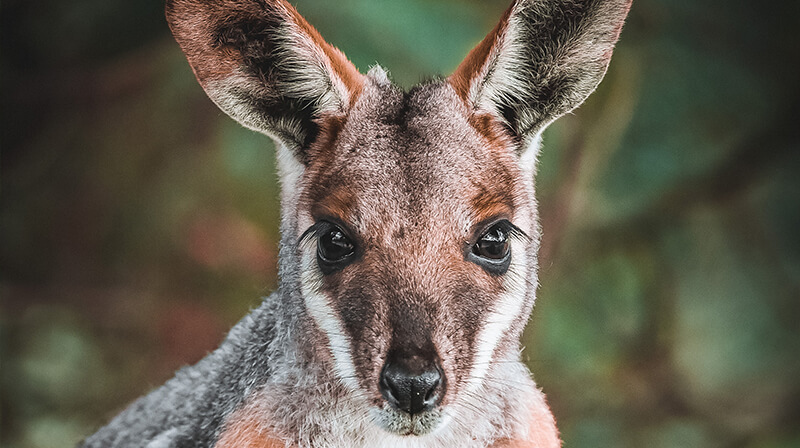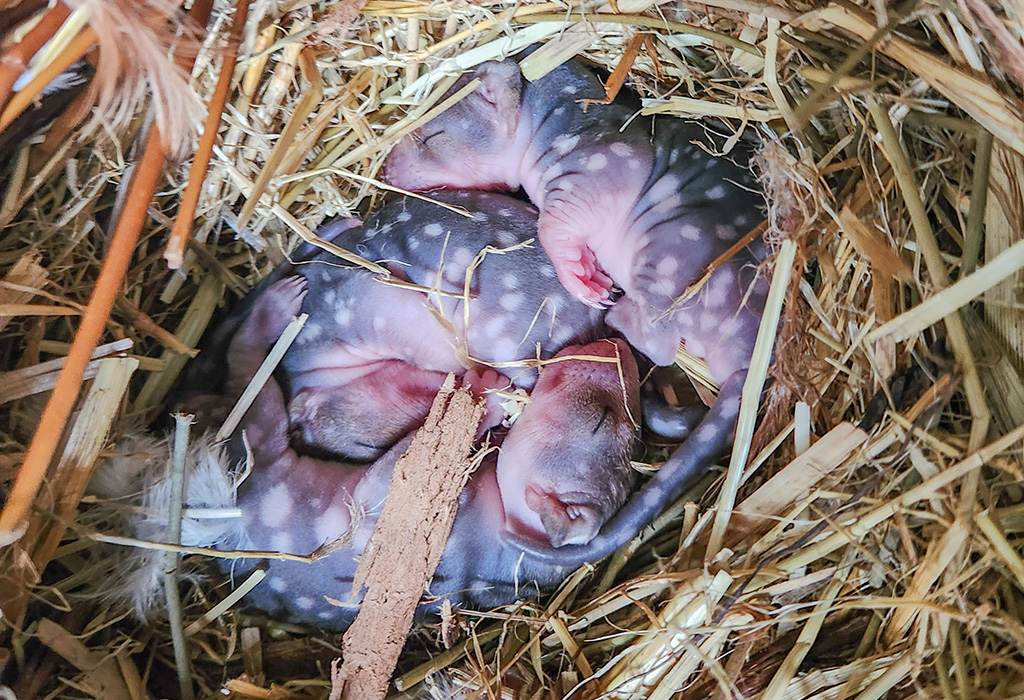Australian Conservation Programmes

A small migratory parrot that crosses the sea on its migration, Orange-bellied Parrots breed in south-west Tasmania in the summer and migrate to the coast of south-east mainland Australia for the winter. The migration route includes the west coast of Tasmania and King Island. They spend much of their day either on or close to the ground and often while a group is feeding, they will take it in turns as a sentinel to sit on a high perch to check for dangers such as hawks.
In summer, soon after arriving back in the melaleuca area in southern Tasmania, pairs begin to form and seek out nest sites. They nest in tree-hollows in trunks and holes in dead branches with pairs known to return to the same nest site for many years. When a female accepts a nest site, she will spend up to a week in the nest preparing it for her brood. During this time, while she incubates and when the chicks are small, the male feeds the female on the nest. When chicks are about ten days old, both parents forage and return to the nest to regurgitate food for the young.
A captive breeding program, which was initiated with birds recruited from a small wild population, has focussed on understanding the birds’ behaviour and dietary needs to boost the production of offspring. The preparation of birds for release into the wild has included teaching the birds to feed on the favoured wild plants utilised by the wild birds and fitness training for life in the wild.
Decline in extent and quality of coastal salt marsh habitat, because of development, agriculture and interference with water systems has impacted the species’ mainland wintering habitat. As they forage on the ground, they are likely to be predated by foxes and feral cats on the mainland. Lack of natural burns at the breeding site has impacted native food resources there. Infectious disease outbreaks are also a threat to their population.
Due to the efforts of a range of optimistic and dedicated conservationists the wild population has risen to over 80 birds returning to nest in December 2023. Annual releases have occurred for many years with birds released both at the breeding grounds in Tasmania and along the Victorian coastline. During the mainland release birds are fitted with a radio transmitter and their movements and survival tracked by dedicated volunteers. To assist the valuable breeding females, they have also been assisted in their migration by flying them back to their breeding grounds by aeroplane. Conservation staff have also provided many artificial nest boxes in their breeding grounds which the birds are using well.
A significant captive breeding program that includes a variety of partners and zoos now manage a captive population of over 500 birds.

The Tasmanian devil Sarcophilus harrisi is a carnivorous marsupial of the family Dasyuridae. The name Sarcophilus means “Flesh-lover”. It was formerly present across mainland Australia but became extinct there around 3,500 years ago. The size of a small dog, the Tasmanian devil became the largest carnivorous marsupial in the world following the extinction of the thylacine in 1936. It is related to quolls, and distantly related to the thylacine. It is characterised by its stocky and muscular build, black fur, pungent odour, extremely loud and disturbing screech, keen sense of smell, and ferocity when feeding. The Tasmanian devil’s large head and neck allow it to generate among the strongest bites per unit body mass of any extant predatory land mammal. It hunts prey and scavenges on carrion.
Tasmanian devils are threatened by Devil Facial Tumour Disease (DFTD) is the name given to a fatal condition in Tasmanian devils which is characterised by the appearance of obvious facial tumours. The tumours are first noticed in and around the mouth as small lesions or lumps. These develop into large tumours around the face and neck and sometimes even in other parts of the body. Badly affected devils have many tumours throughout the body.
The captive breeding programme consists of animals that have been tested not to carry the virus and consists of approximately 600 animals spread across a variety of captive institutions on the mainland and in Tasmania. Some organisations have created large camps in which devils have been released and are thriving. Captive bred animals have also been released onto offshore islands such as Maria where post release, the population has thrived.

Listed as threatened, the Brush-tailed rock-wallaby occurs in fragmented populations roughly following the Great Dividing Range from southwest Queensland to western Victoria’s Grampians. They live on rocky escarpments, granite outcrops and cliffs, which have caves and ledges for shelter.
The population declined greatly after European settlement when people hunted the species for their pelts. Foxes are well known to prey on brush-tails and have been the primary reason for the failure of some of the attempts to release into the wild.
It was estimated in 2020 that there were less than 100 Southern Brush-tailed Rock-wallabies left in the wild in Australia. The Southern Brush-tailed Rock-wallaby (sub-species) program was established in 1996 when there was estimated to be about 40 left in the wild. The initial focus was to build up a captive population as quickly as possible for re-introduction. To achieve this a technique called cross-fostering of joeys to yellow-footed rock wallabies was used to rapidly accelerate breeding. The technique was highly successful – the captive population grew enough to allow for the first trial re-introduction in 2008 in the Grampians National Park. This method improved the understanding of reintroductions developing novel approaches for improving reintroduction success. Large fenced, and predator proof areas, such as Mount Rothwell, are proving very successful in breeding numbers of this species. Genetic diversity is a challenge for this species and scientists have been working on a programme to maximise genetic diversity.
The population at our zoo are part of the original captive breeding programme to act as an insurance against the extinction of the species.

The most beautifully coloured wallaby, the yellow-footed choose to live on rocky outcrops where they are adapted to bound effortlessly across the rocks. They will drink water if available but can survive for much of the year without water by obtaining it from their food. They’re usually best seen in the early morning or late afternoon basking on rocky ledges in the sun.
There are two populations, about 2000 animals in South Australia and another 200 in New South Wales. Their decline was due to introduced foxes and feral cats as well as competition for food from domestic stock and fires. Significant effort by conservation agencies including a captive breed and release programme by zoos has seen the species gradually increase in numbers. Aboriginal landowners have managed a very successful conservation programme in South Australia. The bounce back of the species in the Flinders Ranges has been exceptional with park visitors now regularly seeing the species in the ranges.
The Yellow-footed Rock-wallaby has played a key role in Zoos South Australia’s highly successful wallaby cross-foster program. Under this program a critically endangered Victorian Brush-tailed Rock-wallaby joey is removed from its mother and fostered by a Yellow-footed Rock-wallaby. This in turn allows the critically endangered Brush-tailed Rock-wallaby to give birth to another joey approximately 30 days later increasing the amount of offspring one female can produce in a year. The surrogacy program has assisted in building the population of the species with less than 60 individuals remaining in the wild.

There are four species of quolls. The largest species, also known as tiger quolls, the spotted-tailed quoll is the second largest carnivorous marsupial on the Australia mainland after Tasmanian devils. They live in a variety of habitats, are mainly solitary animals and will make their dens in rock shelters, small caves, hollow logs, and tree hollows and feed on prey such as possums, bandicoots, rabbits, birds, and reptiles.
Quolls have a fascinating breeding cycle – The female calls or “clucks” when she is in oestrus (season) and her neck swells. After a gestation period of 3 weeks, she will give birth to up to thirty young. When spotted-tailed quolls give birth, their offspring are about the size of a grain of rice and up the fur on the mother’s belly and into the pouch where they attach on to a teat. With only 6-7 teats available only that number of young can survive. The mother carries her joeys in her pouch until about 2 ½ months of age at which point, they are left in a nest in the den. The young are then weaned and are independent at 5 months and mature by one year of age. They are short lived with a life expectancy of only up to five years. The joeys grow to about 2 kg for females and 4 kg for males, by the time they reach adulthood.
The spotted-tailed quoll population is seriously threatened throughout mainland Australia. Listed as endangered on the mainland, the introduction of feral animals such as foxes, cats, and dogs, as well as diseases and the logging of their forest habitats, have greatly reduced their numbers. Historic logging of forests and the threat of global warming has for the first time seen many previously very wet forests drying with some even burning.
Several new forest reserves and linkages have been created where the species has been recorded. Feral animals, in particular fox and cat control measures, are being implemented in key habitats. To avoid conflict with people tips on how to “quoll proof” hen houses has been made available. Camera traps and trained scat/scent dogs are being used to detect and monitor populations.
A captive breeding insurance population is managed in Australian wildlife parks and zoos such as ours. Genetics are tightly managed and being relatively short-lived, animals are moved between organisations for breeding on a regular basis.
Our Zoo is one of the top breeding facilities for this species with over forty bred over a twelve-year period.

The Bush Stone-curlew (Burhinus grallarius) is a large, ground-dwelling bird of extraordinary grace and beauty. It is endemic to Australia and nearby islands. It was formerly known as the Bush Thick-knee.
Threats to the bush stone-curlew include:
- predation by foxes and cats
- trampling of eggs by cattle
- clearance of woodland habitat for agricultural and residential development
- modification and destruction of ground habitat through removal of litter and fallen timber, introduction of exotic pasture grasses, grazing and frequent fires disturbance in the vicinity of nest sites.
Numbers have declined greatly over the last century. The bush stone-curlew is now endangered in NSW and were once widely distributed in Victoria. Sadly, they have suffered a significant decline, and it is estimated there are fewer than 300 breeding pairs left on the Northern Victorian Plains where it is now listed as critically endangered. One of the main problems affecting this ground-dwelling bird is that their chances of breeding successfully are very low. Curlew eggs and young are particularly vulnerable to predation by foxes and cats.
A stone-curlew working group bred and released a total of 85 young bush stone-curlews over 8 releases at two locations in southern NSW from 2008 to 2017. The group conducted the first successful release of bush stone-curlews in Australia and has been the driving force behind the establishment of numerous other similar programs across southeastern Australia. Many of the birds from these early releases have survived and been found breeding in the wild where predator control has been implemented and suitable habitat exists.
There is a managed captive breeding programme, which our birds from part of, and there are plans to release some of the offspring into suitably managed natural areas. While they are generally reliable breeders, it can take some pairs a few years to settle and breed successfully.
Follow us @hallsgapzoo
Error: No connected account.
Please go to the Instagram Feed settings page to connect an account.
